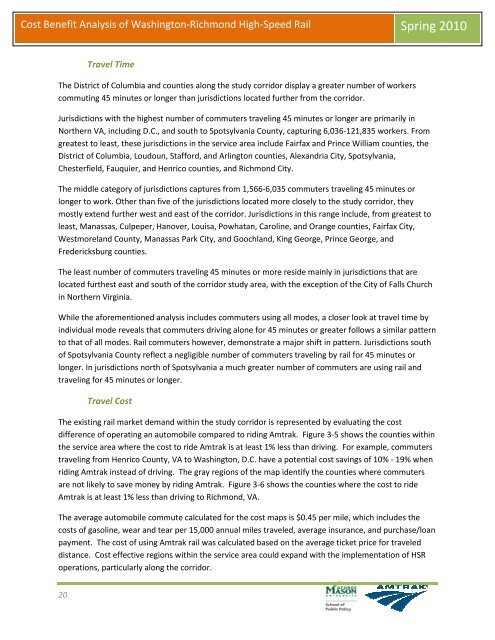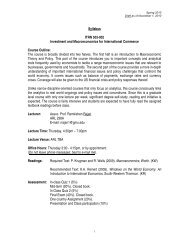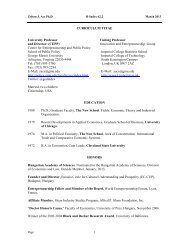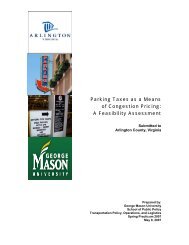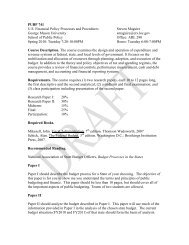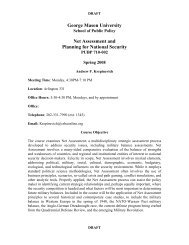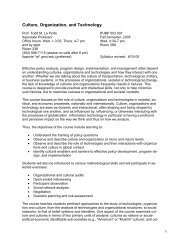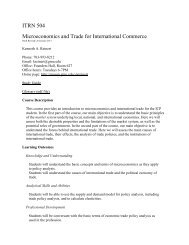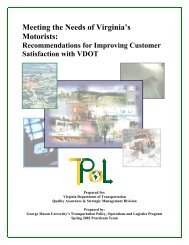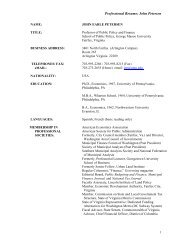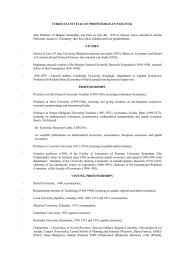Cost Benefit Analysis of Washington-Richmond High-Speed Rail
Cost Benefit Analysis of Washington-Richmond High-Speed Rail
Cost Benefit Analysis of Washington-Richmond High-Speed Rail
Create successful ePaper yourself
Turn your PDF publications into a flip-book with our unique Google optimized e-Paper software.
<strong>Cost</strong> <strong>Benefit</strong> <strong>Analysis</strong> <strong>of</strong> <strong>Washington</strong>-<strong>Richmond</strong> <strong>High</strong>-<strong>Speed</strong> <strong>Rail</strong> Spring 2010<br />
20<br />
Travel Time<br />
The District <strong>of</strong> Columbia and counties along the study corridor display a greater number <strong>of</strong> workers<br />
commuting 45 minutes or longer than jurisdictions located further from the corridor.<br />
Jurisdictions with the highest number <strong>of</strong> commuters traveling 45 minutes or longer are primarily in<br />
Northern VA, including D.C., and south to Spotsylvania County, capturing 6,036-121,835 workers. From<br />
greatest to least, these jurisdictions in the service area include Fairfax and Prince William counties, the<br />
District <strong>of</strong> Columbia, Loudoun, Stafford, and Arlington counties, Alexandria City, Spotsylvania,<br />
Chesterfield, Fauquier, and Henrico counties, and <strong>Richmond</strong> City.<br />
The middle category <strong>of</strong> jurisdictions captures from 1,566-6,035 commuters traveling 45 minutes or<br />
longer to work. Other than five <strong>of</strong> the jurisdictions located more closely to the study corridor, they<br />
mostly extend further west and east <strong>of</strong> the corridor. Jurisdictions in this range include, from greatest to<br />
least, Manassas, Culpeper, Hanover, Louisa, Powhatan, Caroline, and Orange counties, Fairfax City,<br />
Westmoreland County, Manassas Park City, and Goochland, King George, Prince George, and<br />
Fredericksburg counties.<br />
The least number <strong>of</strong> commuters traveling 45 minutes or more reside mainly in jurisdictions that are<br />
located furthest east and south <strong>of</strong> the corridor study area, with the exception <strong>of</strong> the City <strong>of</strong> Falls Church<br />
in Northern Virginia.<br />
While the aforementioned analysis includes commuters using all modes, a closer look at travel time by<br />
individual mode reveals that commuters driving alone for 45 minutes or greater follows a similar pattern<br />
to that <strong>of</strong> all modes. <strong>Rail</strong> commuters however, demonstrate a major shift in pattern. Jurisdictions south<br />
<strong>of</strong> Spotsylvania County reflect a negligible number <strong>of</strong> commuters traveling by rail for 45 minutes or<br />
longer. In jurisdictions north <strong>of</strong> Spotsylvania a much greater number <strong>of</strong> commuters are using rail and<br />
traveling for 45 minutes or longer.<br />
Travel <strong>Cost</strong><br />
The existing rail market demand within the study corridor is represented by evaluating the cost<br />
difference <strong>of</strong> operating an automobile compared to riding Amtrak. Figure 3-5 shows the counties within<br />
the service area where the cost to ride Amtrak is at least 1% less than driving. For example, commuters<br />
traveling from Henrico County, VA to <strong>Washington</strong>, D.C. have a potential cost savings <strong>of</strong> 10% - 19% when<br />
riding Amtrak instead <strong>of</strong> driving. The gray regions <strong>of</strong> the map identify the counties where commuters<br />
are not likely to save money by riding Amtrak. Figure 3-6 shows the counties where the cost to ride<br />
Amtrak is at least 1% less than driving to <strong>Richmond</strong>, VA.<br />
The average automobile commute calculated for the cost maps is $0.45 per mile, which includes the<br />
costs <strong>of</strong> gasoline, wear and tear per 15,000 annual miles traveled, average insurance, and purchase/loan<br />
payment. The cost <strong>of</strong> using Amtrak rail was calculated based on the average ticket price for traveled<br />
distance. <strong>Cost</strong> effective regions within the service area could expand with the implementation <strong>of</strong> HSR<br />
operations, particularly along the corridor.


